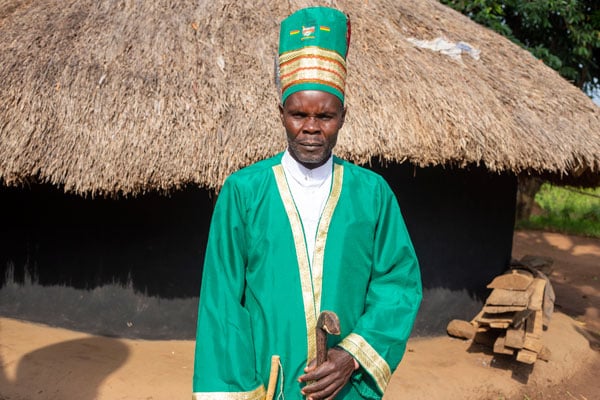
Yekonia Matua is the Chief of the Igmbatama, the newest clan of the Kebhu tribe in Uganda’s West Nile subregion
On a cool morning in Kebu Cell, Arua City, a middle-aged man sits casually on a wooden chair in his sitting room directly facing the entrance to his house. The pile of books that lies on the table in front of him suggests that he is an ardent reader.
“You are welcome,” he tells his four visitors in a gentle tone, his narrow eyes rolling calmly, but intently, from one person to the other as they walk in and take their sits.
He looks so simple in his attire of blue shorts and a white t-shirt. But the regalia that hang above his head reveal a different picture. They are a symbol of power and spirituality, the holder of which wields authority.
Yekonia Matua is the Chief of the Igmbatama, the newest clan of the Kebhu tribe in Uganda’s West Nile subregion.
His coronation ceremony, which took place on January 21, 2023, is one of the latest major steps by the little known tribe to mobilise its people for self-identity, and to strengthen their status as an independent cultural institution, led by the Tebizi (Paramount Chief), currently Ephraim Kebbi Waringu.

Matua displays a calabash for drinking water. Photo/ William Odinga Balikuddembe.
“The Igmbatama Chiefdom of Arua was formed by the Kebhu Rigangi (Kebhu Chiefdom) to cater for the Kebhu living in Arua [and its neighbouring places]. My responsibility is to unite them, collect taxes from them on behalf of the kingdom, make sure that they send their children to school so that we can be competitive in this world, and also link the Kebhu to other cultural institutions such as the Kakwa, Nubi, and the Alur,” says Matua.
Power and authority
“The Leopard skin [hanging above] stands for peace, security and authority. If you have been enthroned as a chief you have to look for it from all corners. I got this one from [the Democratic Republic of] Congo”, explains Matua. His guests include Gulu University History Scholar Dr. Agatha Alidri, her research assistant Hayden Jarombo, their guide – the Chair of the Kebhu community in Arua City Elias Abeka, and this writer.
“The stick [hanging up] wields authority. If you are a Kebhu chief people have to fear you. They have to respect you. If you are asked to come to the chief you must come. If I point this stick at you out of anger, or if you make a mistake and I point it at you, it is a curse. You will fall sick until you meet the obligations or come to the chief,” Matua adds.
Who are the Kebhu?
The Kebhu are one of the least known tribes in Uganda although they are not as few as the Lendu, the Ik or the Batua minorities. Most of them live in Zombo District where they occupy parts of Kango, Zeu, Alangi and Akaa sub counties, and across the border in the Democratic Republic of Congo (DRC).
A Central Sudanic speaking people, the Kebhu are among the earliest settlers of West Nile – between 1000 and 1600 – having followed the Lendu through a migration path both tribes orally trace from the Middle East via Egypt and Sudan (including present day South Sudan).
Kebhu elders say that the Kebhu are many in Uganda but are only dispersed and swallowed up by larger tribes, with many of them, out of inferiority complex, identifying themselves as Alur, Lugbara or Madi.

The Kebhu population estimates are extremely varied. The National Population and Housing Census 2014 put their figure at just 54,000. The Bible Society of Uganda puts their number at about 300,000. Another source, People Groups, puts them at nearly 500,000 in Uganda and more than 700,000 globally.
Kebhu art and culture
Historically, the Kebhu are known in West Nile as the masters of blacksmithing. They are the skilled makers of household, farm and war tools including hoes, knives, spears and machetes. Amidst the industrial production and global trade in such tools, and the dominance of other tribes, however, the Kebhu are not only struggling to preserve their art but also their ethnic identity and culture.
Matua keeps a furnace for smelting iron ore under one of the trees in his compound especially for the Kebhu of Igmbatama to learn about the art mastered and diligently executed by their forefathers.
Under the Arua Kebhu Community Project, the Kebhu in the Diaspora are contributing towards the construction of a hall at Matua’s home where the Kebhu can gather and learn about their culture as well as discuss issues concerning their community.
In March 2021, the Kebhu of Uganda and their tribe mates from the DRC gathered at Mvuranyi Primary School in Zombo and compiled a profile of their cultural institution.
The profile highlights their clans, cultural values, leadership structure and natural resources, among other things. This 60-page A5 paper booklet is the first official book of the Kebhu Rigangi.
Dr. Alidri, who is studying and documenting the cultures and history of marginalised ethnic groups in West Nile, says that like the Lendu, the Kebhu have been “politically, socially and economically excluded” for a very long time.
“Alur imperialism”
“They [Kebhu] suffered ‘Alur imperialism.’ Because of their well structured political system and a big population the Alur colonised the Lendu and the Kebhu. They imposed their rule on them. The Alur were also used by the European colonialists to dominate the Lendu and the Khebu,” says Dr Alidri.

Dr Alidri admires a hoe made by the Kebhu.
“During migration wherever the Lendu went the Kebhu followed. And the Kebhu normally settled where there was iron ore. They named the places where they passed and the evidence is: Kuluva Lugbara) which comes from Kuluriva, meaning ‘they have arrived’; Enjeva (Lugbara pronunciation) is from the Kebhu word Kenjeva which means ‘day has broken’; Ringili (Lugbara) is from Oringili which means ‘tie it properly’; Awindiri (Lugbara) is from Awu-endri which means ‘we come closer’. The names of these places in Arua were given by the Khebu. The Kebhu are known for their indigenous knowledge in making iron implements and that is one thing which contemporary Uganda has not acknowledged,” Dr. Alidri adds.
A distortion of history?
During a blacksmithing demonstration in July last year at Alube in Zombo District, a Kebhu elder claimed that their tools were being displayed in the Uganda Museum as Alur tools. A visit to the museum in November 2023 revealed that there was not a single item displayed as Kebhu. However, a knife called Eligo by the Kebhu – a war weapon and also a symbol of authority held by the Paramount Chief – was on display as an Alur item among the “instruments of punishment.”
Eunice Ngangeyo, a researcher at the museum, said that the museum was undergoing rehabilitation and some items had been moved. But she acknowledged that even before then, some ethnic groups may have not been well represented in the display of artefacts.
“There are many items from Buganda, for example, and a few from other tribes,” said Ngangeyo.
Alur King acknowledges historical unfairness
The king of the Alur, Ubimu Phillip Olarker Rauni III, contends that history has indeed been unfair to some of the ethnic groups in West Nile.
“It is unfortunate that we, the Alur, assimilated some of these groups like the Kebhu and the Lendu and that affected their history. But they were the first people to arrive here [in West Nile]. It is important to document this history,” said King Rauni III during a visit of the researchers at his palace in Atyak Sub County, Zombo District.
“Come out and be counted”
The Kebhu continue to blacksmith, albeit at a rate Kebhu elders are worried is towards the extinction of their age-old trade. And the other key concern for them is the loss of identity among some of them.

“Some Kebhu could even be in the local councils [in Arua] but they fear to show their faces. They are passing off as Lugbara,” says Matua, a former teacher and himself a Councillor for Aivu Division, Arua City.
“Those living among the Alur, Lugbara, Madi e.t.c are called upon to come out and be counted. God, in His wisdom, created you a Kebhu. Accept your ethnicity to honour Him,” reads a statement in the Kebhu profile.




